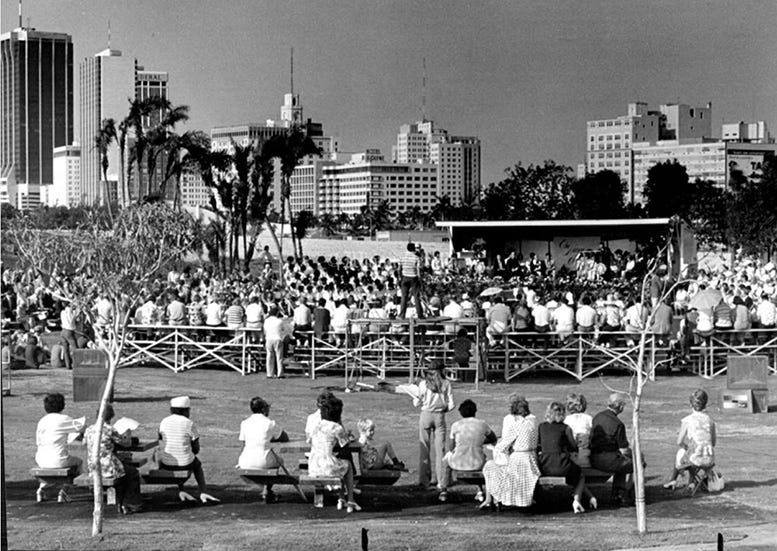Bicentennial Park Dedicated in 1976
As part of the nation's celebration of its bicentennial on July 4, 1976, Miami converted the old Port of Miami into a public park to commemorate the milestone.

After the Port of Miami was completely relocated to Dodge Island by the mid-1960s, its former location along Biscayne Bay was vacant leaving many to wonder what would happen to the land once occupied by the port. Although it took a few years, Miami being named one of four key municipalities to be named a Bicentennial City by President Nixon offered a solution to convert the vacant land to green space that would be officially known as the New World Center – Bicentennial Park.
Given the initiative that provided some federal funding for the park was tied to the country’s 200th birthday, work to convert the port to a park was targeted to be completed by the summer of 1976. The creation of the park coincided with another Bicentennial initiative, favored by city officials, to create a riverwalk along the Miami River from Miami Avenue to the mouth of the stream similar to the Paseo del Rio found in San Antonio, Texas. The hope was that it would one day connect to the walk way along Bayfront Park and eventually to Bicentennial Park.
Although the building of the park progressed slowly, the city scheduled the dedication for July 4th, 1976. The park was close to completion when the city leaders gathered at the park for the ceremony where they were joined by the 350-member interdenominational chorus who sang “one nation under god” to celebrate 200 years of freedom in America. The dedication ceremony was conducted at 1:00pm and was followed by a flyover by four Phantom II fighter jets from Homestead Air Force Base saluting the new park and the nation.
One of the biggest criticisms of the park when it opened was the obvious lack of parking. The city wanted to maximize green space and chose to not include public parking spaces, which left few options to utilize the park for those not within walking distance. The city did provide tram service to shuttle people to the park from selected locations throughout downtown, and even included a narrated tour of the park for riders. However, this service was short-lived, leaving those who wanted to enjoy the park a lengthy walk from parking lots that were relatively far from the green space. The parking issue may have contributed to its sparse use after the dedication.
The park was reconfigured, renovated, and renamed to ‘Museum Park’ in June of 2014. In January of 2019, the park was once again rededicated to honor Miami’s first Hispanic mayor, Maurice Ferre. He was mayor of the city from 1973 until 1985 and led the effort for the city to purchase the bayfront land that became Bicentennial Park.
While the park opened with a lot of fanfare in 1976, it never fulfilled the vision that city leaders had for the park in the mid-1970s. Very few people were living in downtown Miami at the time, which led to it being primarily used by the city’s homeless population. From the onset, the park was better known for horrific crimes and vagrancy, than a public green space that could be enjoyed by families and visitors to the city.
With each passing year, Maurice Ferre Museum Park is getting more use. On the northern edge of the park are two of Miami’s most popular museums. Given the size of the park and its proximity to the bay, it’s being better utilized today than it was when it was dedicated during the nation’s bicentennial. When the park was reconfigured in the early 2010s, it remedied the primary complaint of Bicentennial Park and provided a couple rows of public parking spaces in the park.







KC & the Sunshine Band performed at the opening of this park.
I remember going there once as a child. I'm glad it has been reconfigured successfully into Museum Park.